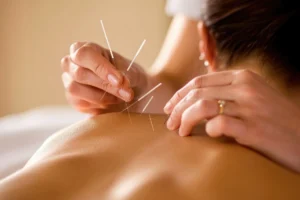Does Dry Needling Actually Work?
Overview of Dry Needling
Dry needling is a technique used by physical therapists to relieve muscle pain and improve function. It involves inserting fine, stainless steel needles into specific trigger points within the muscle. These trigger points are areas of tightness or hyper-irritability in the muscle tissue.
Mechanism of Action
The primary mechanism by which dry needling works is through the stimulation of trigger points. By inserting needles into these tight areas, therapists can help to release muscle tension, improve blood flow, and reduce inflammation. The process may also trigger the body’s natural pain-relieving mechanisms by stimulating neural pathways and producing endorphins.
Scientific Evidence for Effectiveness
There is a growing body of scientific evidence supporting the effectiveness of dry needling for various conditions. Studies have shown that dry needling can be effective in reducing pain, improving range of motion, and enhancing muscle function. However, it is important to note that the effectiveness can vary from one individual to another and may depend on the specific condition being treated. Research continues to evolve, providing more insights into its benefits and limitations.
Conditions Treated by Dry Needling
Dry needling is used to treat a variety of conditions, including but not limited to myofascial pain syndrome, chronic tension headaches, temporomandibular joint (TMJ) disorders, shoulder pain, neck pain, and lower back pain. Athletes often use dry needling as part of their recovery process to address muscle tightness and enhance performance.
Comparison to Acupuncture
Which one is better, dry needling or acupuncture? While dry needling and acupuncture both involve the insertion of needles into the body, they are distinct techniques with different goals. Acupuncture is a component of traditional Chinese medicine aimed at balancing the body’s energy flow, or qi. Dry needling, on the other hand, is rooted in Western medicine and focuses on muscle pain and dysfunction by targeting specific trigger points. Both techniques have their benefits, and the choice between them often depends on the patient’s condition and personal preference.
Dry needling benefits prominently feature muscle pain relief, enhanced range of motion, and quicker recovery times, making it a beneficial addition to physical therapy regimens for suitable candidates.
Schedule your appointment today at Bull City PT’s Durham – Charlotte – Brier Creek – Cary offices.
What Is Negative About Dry Needling?
Dry needling, while beneficial for some individuals, carries certain risks and complications that should be carefully considered. Understanding these negative aspects can help individuals make informed decisions about their treatment options.
Potential Risks and Complications
One of the primary concerns with dry needling is the potential for adverse outcomes. Some patients might experience pain and discomfort during the procedure, particularly when needles are inserted into sensitive areas. This pain can range from mild to intense, depending on individual pain thresholds and the specific muscles targeted.
Nerve Damage and Other Serious Risks
Although rare, there is a possibility of nerve damage when needles are not accurately placed. If a needle inadvertently punctures a nerve, it can cause significant pain and even temporary or permanent nerve dysfunction. Infection is another concern, as improper sterilization techniques can introduce bacteria into the body, leading to potentially severe complications.
Regulatory and Legal Concerns
Regulatory and legal concerns also exist with dry needling. In some regions, the practice is restricted or illegal due to insufficient regulation and oversight. This lack of standardization can lead to practitioners with varying degrees of expertise and training performing the procedure, increasing the risk of complications.
Pain and Discomfort During the Procedure
Another aspect to consider is the overall discomfort during the procedure. Some individuals may find the sensation of needles penetrating their skin and muscles to be unpleasant. The degree of discomfort can vary depending on the individual’s sensitivity and the skill of the practitioner.
Why Some Critics Consider Dry Needling Bad
Critics of dry needling argue that the risks may outweigh the benefits, especially given the limited and mixed evidence supporting its effectiveness. While some patients report significant relief, others find no improvement or even worsening of symptoms.
Conclusion
In summary, while dry needling offers potential therapeutic benefits, it is crucial to be aware of the negative aspects, including risks, regulatory concerns, and the possibility of pain and discomfort. Consulting with a qualified healthcare provider to discuss these factors can help individuals make better-informed decisions about their treatment options.
How Often Should Dry Needling Be Done?
Recommended Frequency for Different Conditions
The frequency of dry needling sessions can vary according to the condition being treated. For acute muscle pain, frequent sessions such as once or twice a week may be advisable to quickly alleviate the discomfort. Chronic conditions, on the other hand, might require less frequent but more prolonged interventions, often starting with weekly sessions and then tapering off to bi-weekly or monthly as improvements are observed.
It is crucial to follow your physical therapist’s recommendation, as they can tailor the treatment plan based on your specific needs and recovery progress. This individualized approach ensures that you receive the most effective care tailored to your unique situation.
Factors Influencing Session Frequency
Several factors can influence the recommended frequency of dry needling sessions. These may include the severity and duration of the condition, the patient’s response to treatment, and underlying health conditions. For instance, a patient with a high pain threshold and minimal physiological complications might be able to undergo more frequent sessions compared to someone with a complex health profile.
Apart from physiological factors, lifestyles and external circumstances, such as stress levels, physical activity, and even sleep patterns, can also dictate how frequently sessions are required. High-stress levels or poor sleep hygiene might necessitate more frequent sessions to help manage muscle tension effectively.
Guidelines from Health Professionals
Guidelines from health professionals emphasize the importance of a personalized treatment plan. According to the American Physical Therapy Association (APTA), the optimal frequency of dry needling should always be predicated on a thorough examination and ongoing assessment by a trained physical therapist. Adhering to these guidelines ensures that treatment is not just effective but also safe.
It is important that patients openly communicate with their therapists, providing detailed feedback on the pain levels, relief experienced post-session, and any side effects. This dialogue helps refine the treatment frequency, optimizing it for the best outcomes.
Patient-Specific Considerations
Each patient’s needs are unique, and so is their response to dry needling. While some individuals might experience immediate and sustained relief after just a few sessions, others may require longer-term treatment. Age, overall physical health, and the presence of co-morbidities can significantly impact both the treatment outcomes and the timeline.
Furthermore, consistent evaluation and modification of the treatment plan are critical components of care at Bull City PT. Our approach ensures that the frequency and intensity of dry needling sessions are continually aligned with your evolving health status and specific recovery needs.
What should you not do after dry needling?
Dry needling is an effective treatment for many musculoskeletal conditions, but proper aftercare is crucial to maximize its benefits and minimize risks. Let’s explore what you should avoid doing post-procedure and why.
Activities to Avoid Post-Procedure
Immediately after dry needling, it’s essential to avoid certain activities that could interfere with the healing process. Strenuous exercise, heavy lifting, and high-impact activities should be postponed for at least 24 hours. These actions can exacerbate soreness and hinder recovery.
Importance of Rest and Recovery
Rest is integral to recovering from dry needling sessions. Taking it easy allows your muscles to acclimate to the treatment and reduces the likelihood of adverse reactions. Aim for a balance between gentle movement and rest.
Guidelines on Physical Activity
Light, non-strenuous activities such as walking or easy stretching are generally beneficial after dry needling. However, aggressive stretching or engaging in high-intensity workouts can disrupt the needle’s positive effects. Listen to your body and make mindful choices regarding physical activities.
Tips for Optimal Healing and Results
Hydration plays a significant role in your recovery. Drink plenty of water to help flush out toxins released during the dry needling process. Additionally, consider using heat or ice therapy, as advised by your provider, to alleviate any soreness or discomfort. Following these steps ensures quicker and more efficient healing.
When to Seek Medical Attention
While mild soreness and bruising are normal after dry needling, keep an eye out for more severe symptoms such as intense pain, swelling, or signs of infection. If you experience these uncommon but serious symptoms, contacting your healthcare provider promptly is crucial.
Trust Bull City PT to guide you through every step of your dry-needling journey. Our Brier Creek location excels in personalized treatments and post-care support, ensuring your path to recovery is smooth and effective. Schedule your appointment today and invest in a healthier, pain-free future.







